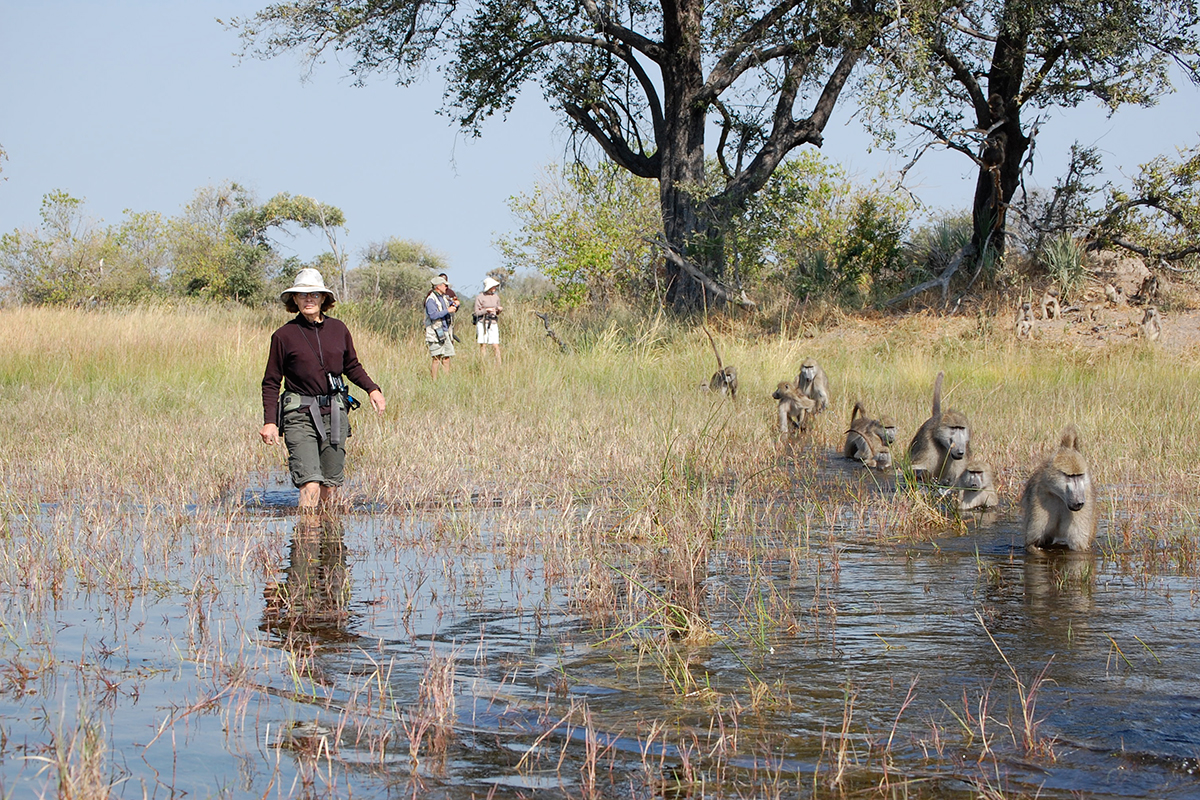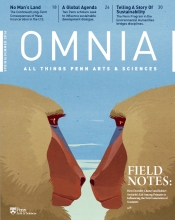Field Notes: How Dorothy Cheney and Robert Seyfarth’s Life Among Primates Is Influencing the Next Generation of Scientists (Featuring Bonus Audio)

Listen to an extended audio interview with Cheney and Seyfarth about their life in the field:
A mother’s distress at the sound of her young being threatened—what could be more natural? But Dorothy Cheney and Robert Seyfarth weren’t just the watching the mother. They were watching her friends—the community. And the response spoke volumes. “Two nearby females looked at the mother, as if to say, I know that scream, that’s that juvenile, and that juvenile belongs to you,” says Cheney. “And that was one of our aha moments, the first indication that baboons recognized the relationships that existed among others, and that you could demonstrate this experimentally.”
It was 1992 when Dorothy Cheney, professor of biology, and Robert Seyfarth, professor of psychology, began their long-term study of free-ranging baboons in the Okavango Delta of Botswana. The wife-and-husband team, together with a group of graduate students and postdocs, spent the next decade and a half documenting the behavior, communication, and social cognition of these group-living primates. This work culminated in their highly influential 2007 book Baboon Metaphysics. Since then, the pair, set to retire this year, have published a multitude of scholarly articles and studies in prominent journals such as Proceedings of the National Academy of Sciences and Animal Behaviour, including “The Evolution of Language From Social Cognition,” “Affiliation, Empathy, and the Origins of Theory of Mind,” and “The Extent and Limits of Cooperation in Animals.” Cheney’s and Seyfarth’s legacy looms large over the field of primate study, influencing a new generation of researchers from a plethora of different disciplines.
Life in the Field
The pair’s first field study, under Robert Hinde, an eminent animal behaviorist at the University of Cambridge, was where they first became acquainted with baboons. “We were really lucky to get in at the ground level, because no one had really focused in on individual primates’ social behavior,” says Cheney. “The first person to do this was Jane Goodall and a lot of scientists criticized her for being overly anthropomorphic and trying to give her study subjects personality. Of course, it turned out she was right.”
But Cheney and Seyfarth longed to dig deeper, to employ new concepts and novel experiments in order to gain a better understanding of what wild primates were really like. “Modern psychology is designed to embark on a scientific study of personality, of social relationships,” says Seyfarth. “So the question was, why shouldn’t we be able to do that on nonhuman primates? After all, we’re really interested in what it is that makes our social behavior and social relationships different from those of animals.”
Prior to Botswana, Cheney and Seyfarth studied vervet monkeys in Kenya for 11 years, at a camp they kept staffed by students and colleagues year round. “We had to come back to the university to teach, and you can only get in the field for so much time,” says Seyfarth. “And with monkeys, it’s not like anthropology where you can go back to the tribe that you visited two years ago and get them to tell you what happened while you were away. Somebody’s got to be there all the time. So every day, we or our students would go out and study these animals.”
“In Botswana you have a rarefied experience because you’re in the middle of nowhere in a kind of Disneyworld of nature ... and we always preferred working on animals in the wild because you can study them in the context in which presumably their behaviors evolved without the interference of humans.”
When they transitioned to the camp in Botswana, Cheney and Seyfarth knew they had found something special. “In Botswana you have a rarefied experience because you’re in the middle of nowhere in a kind of Disneyworld of nature ... and we always preferred working on animals in the wild because you can study them in the context in which presumably their behaviors evolved without the interference of humans.”
Not only did the pair put down roots, they eventually moved their daughters to the camp as well. “Our two daughters spent about half their life, up until high school, going back and forth to these tents, where they would more or less teach themselves their school curriculum,” says Seyfarth. “This is a camp where elephants and lions wander through. It’s an extraordinary existence. Our daughters still return to this day.”
There are a few dangers in the field. Elephants, for example, pose a trampling risk for humans if they veer too close. It was a lion, though, that left the biggest impression. “It’s a good story to tell afterwards, but it was not a pleasant experience at the time,” laughs Seyfarth. “Usually in the savannah people are walking in groups and the animals tend to stay away, but I was walking alone. From a group of seven a rather aggressive lion took up chase. The first thing you learn is not to run or you’re the ball of yarn. So I walked slowly to the nearest tree and went up. At the time I thought, thank goodness, this tree has these little knobs on the trunk, and it was just like going up a ladder. But later when I went to revisit the tree, it had smooth sides. So it was pure adrenalin that got me up there.”
As Cheney and Seyfarth began using audio recordings to reveal the primates’ social bonding behavior, it quickly became apparent they were dealing not just with individuals interacting with each other, but with individuals acutely aware of and interested in the relationships that pertained among other individuals in the group.
The Complex Social Life of Primates
The social life of a primate has more similarities to a human’s than you might think. Take gossip, for instance: “These are voyeurs, essentially, and as a result, you can show that the animals recognize not only their own relationships and dominance ranks, but also those of others,” says Cheney. “It immediately begs the question, of what advantage is it to you to be acutely aware of what other individuals are doing? It opens up a whole new view of social behavior in animals, where there are complex relationships beyond the level of just the pair that’s interacting with each other.”
Whenever a complex social hierarchy exists, Seyfarth says there’s an inevitable give and take. “The structure of primate society introduces the fundamental dilemma that any group-living animal faces: You’re better off living in a group than being on your own, and yet when you join a group you also acquire a number of competitors.”
One of the breakthrough developments in regard to this dilemma was the pair’s study of reconciliation. They found that when two animals got into a fight, they sometimes reconciled with each other afterward, the way humans might.
“The structure of primate society introduces the fundamental dilemma that any group-living animal faces: You’re better off living in a group than being on your own, and yet when you join a group you also acquire a number of competitors.”
The most common form of reconciliation in baboons is a simple grunt. Cheney and Seyfarth were able to observe primates making threatening gestures, and then a few minutes later those same dominant individuals would return and grunt, which the researchers describe as “greasing the social wheels and facilitating interaction.” In subsequent experiments they played the grunt of a close relative of the initial aggressor. “We got the same sort of result, suggesting that the victim was, in her mind, saying, ‘I was threatened by Betty. Betty chased me. Now I hear Betty’s daughter grunting to me, so I guess everything is okay with that family now,'” says Cheney.
The social stratification created by dominance hierarchies manifests itself in other decidedly human ways. For instance, low-ranking females might potentially have a lower fitness, or reproductive rate, due to food scarcity. But the long-term data Cheney and Seyfarth collected show that low-ranking females can overcome this limitation by forming close bonds with other females—bonds that are correlated with better offspring survival and greater longevity. The pair say this is one of the most striking results to emerge from their 16-year study, and that it makes them wary of research on monkeys in captivity, where individual monkeys can be shifted around from one group to another, disrupting their natural social organization. “If you look at monkeys in captivity, you’ll often find that very low-ranking females have very high levels of stress,” says Cheney. “And in part that’s because their groups are so unstable and so unpredictable that they’re being shifted around all the time, and they don’t have the opportunity to form the strong, enduring social bonds that, it turns out, are a crucial feature of primate life.”
These kinds of dynamic behavioral scenarios inform a recent journal article Seyfarth and Cheney wrote with their former student Michael Platt, GR'94. When he was fresh out of college with an anthropology degree, Platt chose Penn for his graduate work in part because of Cheney’s and Seyfarth’s research on primates. “Dorothy and Robert had been getting quite famous around that time,” says Platt. “They coedited a big volume called Primate Societies that I read as an undergraduate, and so I applied [to Penn] to work with them.” Now, Platt has returned to Penn as the James S. Riepe University Professor. Their recent paper, “Adaptations for Social Cognition in the Primate Brain,” marks a reunion for the three and a potential springboard for future joint research.
A Collaboration 25 Years in the Making
Platt reconnected with his mentors after a two-day symposium at which he and Cheney spoke back to back. “Her presentation naturally just led right into mine, and so it seemed like a great opportunity to try to synthesize what we had been working on,” says Platt, a Penn Integrates Knowledge Professor who has appointments in the Department of Psychology, the Department of Neuroscience in the Perelman School of Medicine, and the Department of Marketing in the Wharton School. “It’s so funny it took us this long to actually write something together.”
The article explores primates’ ability to form cooperative social bonds as an alternative to competition; the adaptive choices that balance competition and cooperation, often with the same partner; and how populations of neurons in the brain specifically encode the type, importance, and value of social information. Platt says it was actually his mentors—a psychologist and a biologist—who helped steer him toward hard neuroscience in the first place. “My career followed a pathway that was opened by Robert and Dorothy because they introduced me to Paul Glimcher, who had been a Ph.D. student and a postdoc here at Penn in the psychology department.”
Glimcher, GR’89, was recruiting researchers for a new neuroscience lab at New York University and invited Platt to join the team. It turned out to be a good fit because Platt’s wife, Elizabeth Brannon—who, like Platt, studied under Cheney and Seyfarth and is now a professor of psychology at Penn—was studying at Columbia University at the time. “Paul basically needed a warm body in the lab to get things started,” says Platt. “I was keen to say to him, ‘I don’t want to do lab research, I’ve been a field guy.’ But he said to me, ‘I can give you the tools, if you just commit to doing the work.’ And it turned out to be true.”
In 1999, Platt and Glimcher co-authored the paper “Neural Correlates of Decision Variables in Parietal Cortex” in Nature, considered one of the seminal articles in the emerging field of neuroeconomics, the interdisciplinary study of decision making. But Platt says with his recent work, he’s come full circle, back to the type of fieldwork Cheney and Seyfarth were pioneering decades ago.
One of Platt’s current projects includes leading a large-scale research program on an island called Cayo Santiago, off the coast of Puerto Rico. The site is famous because in 1938 over 400 rhesus macaque monkeys were brought there from India. The island now houses over 1,600 animals, with half a dozen or more research assistants following the monkeys one at a time, recording everything they do. “They do little experiments like Robert and Dorothy did, like come out of the bushes, holding a picture of a threatening monkey or a monkey from another group, so we can measure their responses,” says Platt.
Researchers also gather blood samples from the monkeys in order to sequence their DNA. They are steadily building up to what Platt says will be one of the largest databases of quantitative behavioral measurements and genetics on known individuals in a naturalistic environment. The data from the island site has already begun to address a lot of the things that Cheney and Seyfarth worked on, like why some monkeys are really socially savvy and others peripheral. “We’re getting the entire read, which allows us to ask whether it’s specific genes or pathways or the whole genetic makeup of the animal that is affecting behavior,” says Platt.
Cheney, Seyfarth, and Platt all attest to the fact that the melding of field and lab work has strengthened their joint research. But the observational component is only possible when studying group-living primates in a stable environment—an opportunity they say is becoming more and more endangered.
Preserving Group-Living Primate Observation
As primate research continues, there is a mounting battle for balanced funding when it comes to lab work versus field studies in more natural settings. The sheer expense and difficulty of replicating a complex living environment—for researchers unable to relocate to a natural environment—often translates into reduced funding for observational studies. According to Seyfarth and Cheney, the loss of social behavioral data would pose a huge risk. “It’s especially frustrating because by not adopting this more evolutionary perspective, science becomes less informative,” says Cheney.
Moving forward, Cheney and Seyfarth say there are many aspects of primate life that bear further investigation, aspects likely possible only if funding for research in natural environments is made available. And the work is by no means simply observational. In fact, one of Cheney’s and Seyfarth’s most important contributions is to bring experimental methods into the field. Vocal communication in primates, a phenomenon the pair have been researching for decades, is of particular interest. “What is it like to say that a monkey knows something when it doesn’t have a word for that something? Vervet monkeys, for instance, have an alarm system where they appear to give different calls to different types of predators,” says Cheney. “It’s almost like they have a word for a leopard, or a word for eagle. And we can show that animals respond differently to these different calls.” But does this mean that, when a vervet monkey hears another vervet’s leopard alarm, it creates the same kind of mental representation that we do when we hear the word “leopard”?
Although there are tantalizing hints that some monkey calls function like words, the vocal repertoires of monkeys and apes are still very limited, especially when compared with our own ability to learn to produce new sounds. Cheney and Seyfarth say very little progress has been made in understanding this limitation, and why monkeys don’t seem to learn phonetically. “Under natural conditions they certainly have interesting vocalizations,” says Seyfarth. “But if they have such a rich understanding of other animals’ calls, why do they produce so few? It’s a real puzzle, because the same animal is both a creative listener and a very limited speaker. Where does this limitation come from? The speech apparatus? The brain? Or is it just a matter of motivation?"
As far as the next generation of research is concerned, Platt says a lot hinges on this ability to use reliable field data to inform lab work. “The way that I think about behavior, and the way I think about the brain, originated from being here, learning from Dorothy and Robert—the way they thought about things,” says Platt, who is planning to work with Cheney and Seyfarth to turn their coauthored piece into a more in-depth review. “I have my lab and my trainees and some are faculty at universities with their own students. And I think the way that Dorothy and Robert think about behavior, cognition, and biology is still alive in all these people. And so we’re sort of terraforming, if you will, at least a small part of the intellectual academy. So we’ll see where it goes. Hopefully they’ll all be really successful.”
Cheney and Seyfarth don’t plan to leave fieldwork behind any time soon. Just this past winter they visited Botswana, and they continue to visit Kenya. “There was a professor who once looked at us and said, ‘God, this fieldwork, you guys are really committed. You practically live with your students,’” says Seyfarth. “And we have in fact lived with a lot of our students, and they’re our friends, and now our children’s friends. So we’ve been very lucky.”







